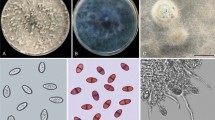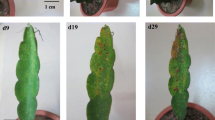Abstract
A stem canker disease of Tatarian dogwood (Cornus alba) was observed in Shandong province of China in 2008. The pathogen was isolated from typical canker tissues and fulfilled Koch's Postulates. The morphological characteristics of the pathogen were determined and the internal transcribed spacer (ITS) region of the rDNA, the translation elongation factor 1-α (EF1-α) and β-tubulin (BT) were amplified by PCR for molecular identification. On the basis of the symptoms, morphological characteristics and sequence data, the pathogen was identified as Botryosphaeria dothidea (anamorph Fusicoccum aesculi). This is the first report of this pathogen on Tatarian dogwood in China, and to the best of our knowledge, the world.





Similar content being viewed by others
References
Begoude BAD, Slippers B, Wingfield MJ, Roux J (2010) Botryosphaeriaceae associated with Terminalia catappa in Cameroon, South Africa and Madagascar. Mycol Prog 9:101–123
Carbone I, Anderson JB, Kohn LM (1999) A method for designing primer sets for the speciation studies in filamentous ascomycetes. Mycologia 95:553–556
Crous PW, Slippers B, Wingfield MJ, Rheeder J, Marasas WF, Philips AJ, Alves A, Burgess T, Barber P, Groenewald JZ (2006) Phylogenetic lineages in the Botryosphaeriaceae. Stud Mycol 55:235–253
de Wet J, Slippers B, Preisig O, Wingfield BD, Wingfield MJ (2008) Phylogeny of the Botryosphaeriaceae reveals patterns of host association. Mol Phylogenet Evol 46:116–126
Denman S, Crous PW, Taylor JE, Kang JC, Pascoe I, Wingfield MJ (2000) An overview of the taxonomic history of Botryosphaeria and a re-evaluation of its anamorphs based on morphology and ITS rDNA phylogeny. Stud Mycol 45:129–140
Desprez-Loustau ML, Marcais B, Nageleisen LM, Piou D, Vannini A (2006) Interactive effects of drought and pathogens in forest trees. Ann For Sci 63:597–612
Glass NL, Donaldson GC (1995) Development of primer sets designed for use with the PCR to amplify conserved genes from filamentous ascomycetes. Appl Environ Microbiol 61:1323–1330
Pavlic D, Slippers B, Coutinho TA, Wingfield MJ (2009) Multiple gene genealogies and phenotypic data reveal cryptic species of the Botryosphaeriaceae: a case study on the Neofusicoccum parvum/N. ribis complex. Mol Phylogenet Evol 51:259–268
Piškur B, Pavlic D, Slippers B, Ogris N, Maresi G, Wingfield MJ, Jurc D (2010) Diversity and pathogenicity of Botryosphaeriaceae on declining Ostrya carpinifolia in Slovenia and Italy following extreme weather conditions. Eur J Forest Res 150:235–249
Saitou N, Nei M (1987) The neighbor-joining method—a new method for reconstructing phylogenetic trees. Mol Biol Evol 4:406–425
Sakalidis ML, Ray JD, Lanoiselet V, Hardy GESJ, Burgess TI (2011) Pathogenic Botryosphaeriaceae associated with Mangifera indica in the Kimberley Region of Western Australia. Eur J Plant Pathol 130:379–391
Slippers B, Wingfield MJ (2007) Botryosphaeriaceae as endophytes and latent pathogens of woody plants: diversity, ecology and impact. Fungal Biol Rev 21:90–106
Slippers B, Crous PW, Denman S, Coutinho TA, Wingfield BD (2004) Combined multiple gene genealogies and phenotypic characters differentiate several species previously identified as Botryosphaeria dothidea. Mycologia 96:83–101
Smith DR, Stanosz GR (2001) Molecular and morphological differentiation of Botryosphaeria dothidea (anamorph Fusicoccum aesculi) from some other fungi with Fusicoccum anamorphs. Mycologia 93:505–515
Stanosz GR, Blodgett JT, Smith DR, Kruger EL (2001) Water stress and Sphaeropsis sapinea as a latent pathogen of red pine seedlings. New Phytol 149:531–538
Tamura K, Dudley J, Nei M, Kumar S (2007) MEGA4: Molecular evolutionary genetics analysis (MEGA) software version 4.0. Mol Biol Evol 24:1596–1599
White TJ, Bruns T, Lee S, Taylor J (1990) Amplification and direct sequencing of fungal ribosomal RNA genes for phylogenetics. In: Innis MA, Gelfand DH, Snisky JJ, White TJ (eds) PCR protocols: a guide to methods and applications. Academic, San Diego, pp 315–322
Acknowledgments
This work was supported by grants from the National Natural Science Foundation of China (31270687, 30972367) and Special Funding for Basic s&t Work of Ministry of Science and Technology of China (2009FY210100).
Author information
Authors and Affiliations
Corresponding author
Additional information
Zong-Xia Zhang and De-Fa Deng contributed equally to the work.
Rights and permissions
About this article
Cite this article
Zhang, ZX., Deng, DF., Qi, WJ. et al. Botryosphaeria dothidea, the causal agent of a new stem canker disease of Tatarian dogwood (Cornus alba) in China. Australasian Plant Pathol. 42, 113–119 (2013). https://doi.org/10.1007/s13313-012-0197-4
Received:
Accepted:
Published:
Issue Date:
DOI: https://doi.org/10.1007/s13313-012-0197-4




